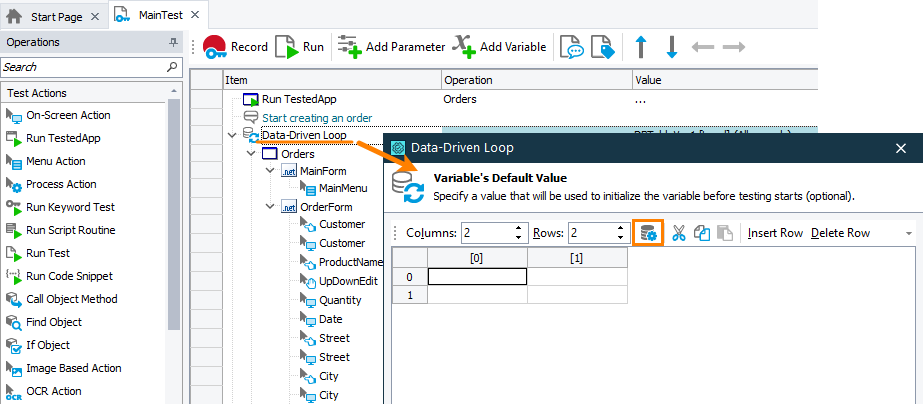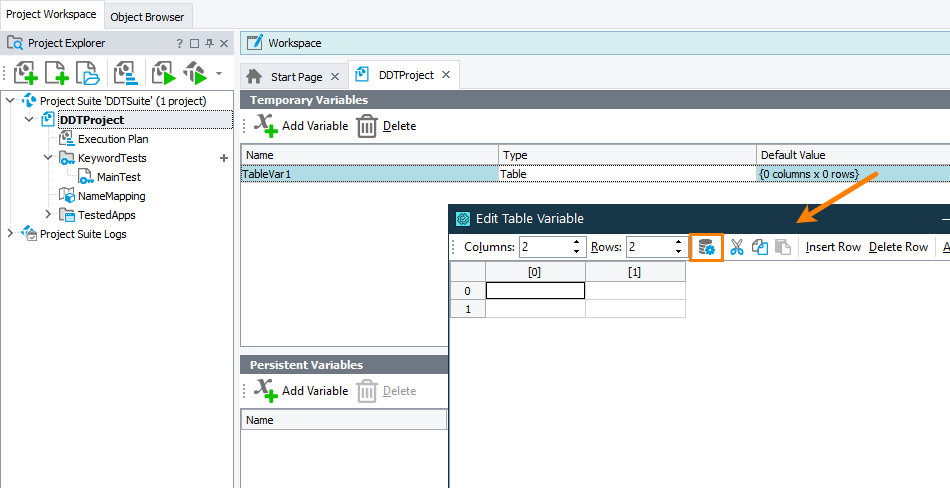The Real generator is used to generate real numbers with TestComplete. Using this generator type you can populate the desired Excel file or TestComplete Table variable with various real numbers and then use this data in your tests. For more information on preparing test data, see Preparing Data for Data-Driven Testing.
To open the generator
-
Click
 on the Tools toolbar or select Test > Generate Data from the main menu to call the Data Generator wizard.
on the Tools toolbar or select Test > Generate Data from the main menu to call the Data Generator wizard. -
In the wizard, select the data storage.
-
On the Data Generation Options page of the wizard, for the needed value, select Real in the Data Generator column.
-
Click Edit in the Parameters column.
– or –
-
When adding a data-driven loop to a keyword test, select a table variable to store loop values.
-
On the Variable’s Default Value page of the wizard, click
 on the toolbar.
on the toolbar.
– or –
When editing a table variable, click  on the Edit Table Variable wizard toolbar.
on the Edit Table Variable wizard toolbar.
Parameters
For the Real generator, you can specify the following parameters:
Generation mode
Generation mode - contains a drop-down list that allows you to specify a generation mode. The available modes are:
- Random - Select this mode to generate random real number values within the specified range.
- Sequential - Default. Select this mode to generate a sequence of values that will start with the value of the Minimum Value parameter (if the Increment value is positive) or with the Maximum Value parameter (if the Increment value is negative). The sequence's increment value is specified by the Increment value parameter. If the generated sequence goes beyond the specified bounds and the number of generated values is less than it is needed, the test engine repeats the generated sequence from the beginning as many times as necessary.
Minimum value
Maximum value
| Note: | The value of the Maximum value parameter must be greater than or equal to the value of the Minimum value parameter. Both parameters can be specified as an integer or as a real number. |
Increment value
| Note: | This parameter is available only if you select the Sequential item in the Generation mode drop-down list. |
Decimal places count
Duplicate each value … time(s)
After you specify the needed parameters, you can obtain the sample values that have been generated by the engine. The values are displayed in the Sample field.
Also, you can discard all the changes you made in the generator’s parameters and restore the parameters set by default. For this purpose, click Set Default Values below the Sample field.
If you are going to use the same settings in several variables or if you configure one generator in the same manner from time to time, it is much easier to save the selected generator with the specified parameter values as a user-defined generator. For this purpose, click the Save to User-Defined button below the Sample field.
If the user wants to use files with UTF-8 or UTF-16 encoding, the files must contain the BOM.
For more information on generating test data, see Data Generator Wizard.
See Also
Data Generator Wizard
Data-Driven Testing
Preparing Data for Data-Driven Testing



